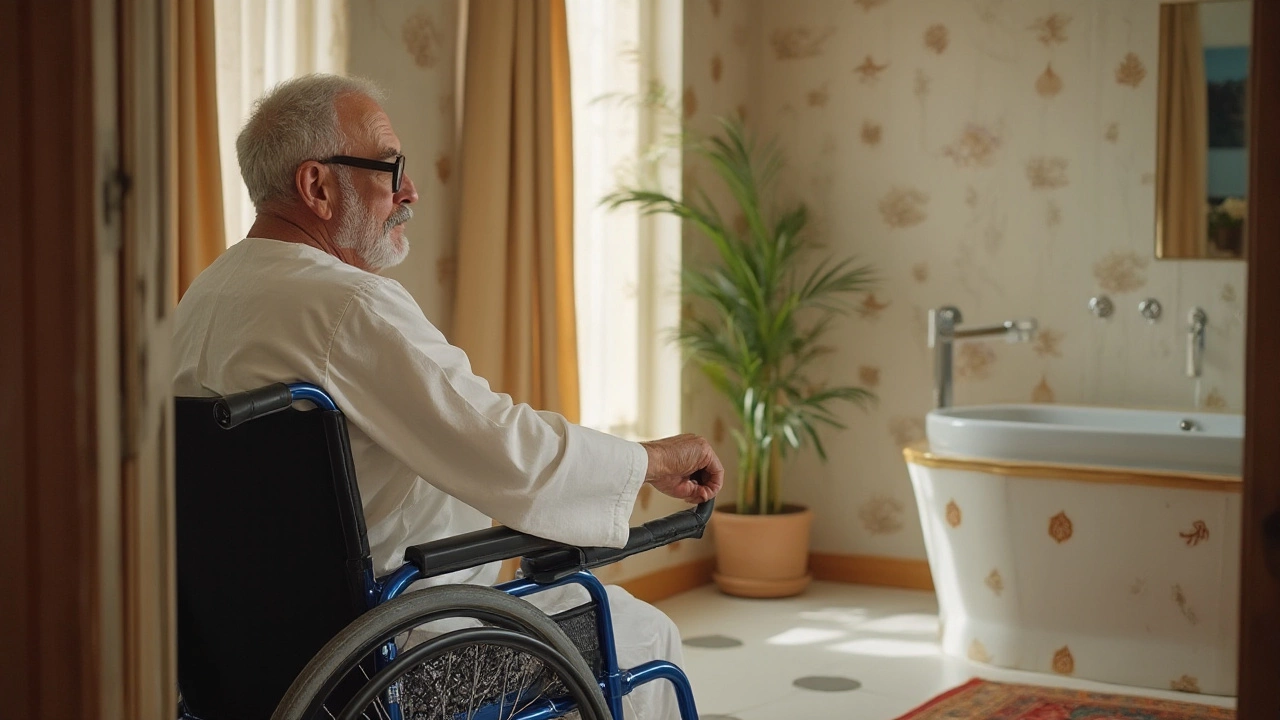Recovering from knee replacement surgery can be an overwhelming journey, filled with physical and emotional hurdles. One often-overlooked aspect is the simple, yet fundamental task of using the bathroom.
For patients, regaining this ability is vital not just for comfort, but also for maintaining dignity during recovery. This guide aims to provide valuable advice on navigating post-surgery bowel movements effectively. By focusing on a balanced diet, regular hydration, and gentle physical activity, you can significantly ease this aspect of your healing process.
- Understanding Post-Surgery Challenges
- Healthy Diet and Hydration
- Physical Activity and Assistance
- Practical Tips for Bathroom Safety
Understanding Post-Surgery Challenges
Knee replacement surgery often comes with a unique set of challenges that can impact day-to-day activities, such as using the bathroom. The first few days post-surgery tend to be the most difficult, as the body is adjusting to the foreign apparatus and the aftermath of anesthesia. Anesthesia can lead to constipation, which complicates bathroom visits. Furthermore, pain medications, especially opioids, are notorious for slowing down the digestive system. This issue, compounded by the reduced mobility experienced after surgery, makes regular bowel movements a daunting task.
Understanding how to manage these challenges begins with acknowledging the changes your body is experiencing. The immediate post-operative phase demands patience and a proactive approach toward recovery. Patients often experience a period of immobility enforced by pain, swelling, and physical constraints. However, maintaining even a minimal level of activity is crucial. Knowing that these difficulties are common can alleviate the psychological stress that sometimes accompanies them. As Dr. Samantha Connors from the National Institute of Health noted, "Patients often benefit from being informed about these challenges, which helps them engage actively in their recovery process." This knowledge equips patients to focus on solutions rather than problems during their recovery journey.
The physical effects are not the only consideration; psychological factors also play a significant role. The sudden dependence on others for simple activities could give rise to feelings of frustration or vulnerability, particularly when facing issues related to bowel movements. For many, the thought of having to ask for assistance with such personal tasks is uncomfortable. Acknowledging these feelings and discussing them openly with healthcare providers is essential. They can provide practical tips on how to navigate these obstacles, such as the strategic use of a walker or commode. It's vital to maintain open communication with your care team and loved ones to ensure a supportive recovery environment.
Technology is also your ally. Newer advancements have created adaptive devices to support independence during recovery. Raised toilet seats, grab bars, and non-skid mats are simple yet effective tools to reduce strain and prevent accidents. These devices promote safety and help maintain a sense of autonomy. Exploring and installing such supportive equipment before surgery can significantly reduce stress when the time comes to use them. As patients become more familiar with these aids, they generally find that their confidence increases, leading to a more positive outlook on their recovery progress. Remember, these adjustments are temporary but significantly beneficial in your path to recovery.
With all these practical aspects covered, it is imperative to highlight the importance of preparation before surgery. Being well-informed and prepared about the challenges you'll face and the resources available to combat them equips you better for what is to come. Prior education on anesthesia effects, pain management, and strategies for gentle physical movement are invaluable. Many surgical centers offer pre-surgery classes or informational material that can be revisited to re-familiarize yourself with what to expect. Engaging with these resources not only prepares you mentally but helps you set realistic goals and expectations for your postoperative journey.

Healthy Diet and Hydration
When you think about recovering from knee replacement surgery, diet might not be the first thing that comes to mind. However, proper nutrition plays a crucial role in facilitating smooth bowel movements and overall healing. Fiber is your best friend after surgery. It adds bulk to your stool and helps move it through the intestines, preventing constipation which is common due to medication and reduced physical activity. Focus on consuming foods rich in fiber, such as fruits, vegetables, legumes, and whole grains. These not only promote digestion but also provide essential vitamins and minerals that aid your body in repairing tissues and warding off infections.
Drinking enough water is equally important. Hydration aids digestion by keeping the stool soft and easy to pass, which is important when you have limited mobility. Aim for at least eight glasses of water a day. Additionally, other fluids like herbal teas or broth-based soups can also contribute to your fluid intake. Remember, keeping hydrated isn't just about drinking water; hydrating foods, like cucumbers, watermelon, and oranges, offer the added benefit of fiber as well. Staying hydrated regulates body temperature, keeps joints lubricated, and delivers nutrients to organs, all of which contribute to post-surgery recovery.
Supplements and Medications
While a balanced diet is crucial, you might also consider supplements. Some post-surgery medications can deplete essential nutrients. Calcium and Vitamin D supplements can support bone health, particularly when recovering from knee surgery. However, always discuss this with your healthcare provider before adding new supplements to your regimen. A high magnesium intake can help as well; it relaxes muscles throughout the digestive tract and attracts water, softening stool consistency.
"Nutrition is a critical component to recovery following surgery," says Dr. Emily Zuccarini, a well-regarded nutritionist. "A balanced diet, rich in diverse nutrients, helps patients regain strength and improves intestinal health."
Consider incorporating probiotics for gut health. These beneficial bacteria can strengthen your digestive system and potentially alleviate constipation. Foods like yogurt, kefir, and sauerkraut are natural sources, though probiotic supplements are available. Keep in mind that maintaining a diet rich in these nutrients isn't just a temporary fix; it's a lifestyle choice that supports a healthy recovery and prevents future complications.
A Sample Daily Meal Plan
Crafting a meal plan post-surgery can seem daunting, but it doesn’t have to be complicated. Here’s a simple plan:
- Breakfast: Oatmeal topped with berries and a sprinkle of flaxseed.
- Snack: A small handful of nuts and an apple.
- Lunch: Lentil soup with a side of mixed greens drizzled with olive oil.
- Dinner: Baked salmon with quinoa and steamed broccoli.
- Hydration: Keep a water bottle nearby to sip on throughout the day.
This meal plan not only ensures a high intake of fiber but also provides ample nutrients required for tissue repair and inflammation reduction. Adhering to a nutritious diet and maintaining proper hydration will not only support your bowels but also enhance your overall recovery experience after a knee replacement.

Physical Activity and Assistance
Embarking on your knee replacement recovery journey means understanding the crucial role of physical activity. Post-surgery, movement is not just beneficial, it's necessary. Initially, even simple exercises can feel daunting. A gentle walk might seem tiresome, yet it's instrumental in improving blood flow, which significantly reduces swelling around the new knee. Most importantly, these exercises prevent blood clots. It’s essential to know your limits and avoid overexertion. Always engage in activities advised by your healthcare team. Consistency is key; regular movement will become more manageable and enjoyable over time. With every step, you'll notice an improvement in joint flexibility, paving the way for a smoother path to normalcy.
Your recovery will likely involve a team of professionals who will guide you through approved activities. Physical therapists, for example, tailor personalized exercises that focus on the muscles surrounding the knee. Exercise regimens often include straight leg raises and ankle pumps, exercises specifically developed to foster the growth and resilience of these critical muscles. It's a slow process but one that's proven to accelerate recovery time. When approaching exercises, positivity is essential to address the mental and emotional hurdles that coincide with physical healing. The added encouragement of a professional can make all the difference.
John Hopkins Medicine states, "Physical therapy is crucial for ensuring the best recovery. It helps regain motion, strength and independence."
Of course, daily life doesn’t stop with surgery, so having adequate assistance is crucial. Household tasks might be more challenging immediately after surgery. Whether it's preparing meals, maintaining personal hygiene, or regular movements around your home, seeking help from family or professional caregivers is a wise choice. These supportive figures can aid in minimizing the strain on your new joint, consequently preventing unnecessary complications. Additionally, gentle reminders from loved ones to stay active and mobile ensure that physical therapy principles extend into daily routines.
When considering assistance items, look for useful tools such as a raised toilet seat or grab bars in the bathroom. These items provide safety and ease of use by supporting your mobility and balance. An essential tip is to use an assistive device like a walker or crutches in the early recovery stages. They offer great help in maintaining balance as your knee strengthens, thus placing less strain on healing tissues. Real-world application of these tools can significantly support maintaining independence, allowing you to focus on getting back to daily activities.

Practical Tips for Bathroom Safety
Venturing into your bathroom after a knee replacement surgery is more than a daily routine – it can be a strategic planning session. Safety becomes a top priority to prevent any slips or falls that could hinder your recovery. Considering the fact that bathrooms are one of the most common areas for home accidents, it's crucial to make yours as safe as possible. Begin by surveying the environment, keeping in mind that mobility may be limited temporarily. The initial goal is to ensure accessibility and comfort. Elevating the toilet seat can be a wise move for those recovering from knee surgery. These raised seats reduce the strain on your knees by minimizing the need to squat low, a task that can be painful and difficult during healing. Adding handrails or grab bars around the toilet area offer additional support. These supportive tools can significantly boost confidence and autonomy as you navigate around the bathroom.
Non-slip bathroom mats are another essential safety feature for preventing accidents as you exit the shower or bathtub. Wet floors are a significant hazard, particularly when you're not able to balance as well as you might under normal circumstances. Pair these with a sturdy shower chair or bench; this allows you to sit while showering, reducing fatigue and lowering the risk of a fall. Adjusting the height of your bathroom fixtures, like sink and mirror, may also contribute to a more comfortable experience as you adapt to new physical limitations. Medical experts suggest keeping necessary toiletries and items within reach to minimize unnecessary movements. Use storage solutions that don't require bending or stretching, and ensure these are easy to open and manage. A simple adjustment like this transforms the bathroom into a user-friendly space, aiding a smoother recovery process.
Lighting is another factor to consider; inadequately lit areas increase the risk for accidents. Brighter bathroom lights or night lights can help maintain a safe environment. Consider replacing your old bulbs with LED ones, offering both brightness and energy efficiency. If possible, having a commode chair or portable toilet available in your room can make night-time journeys safer and easier, providing an alternative when you're too tired or it's too dark to brave the way to the bathroom. Remember to communicate regularly with your partner or caregiver about your bathroom routine and any assistance you might need.
"The first step in the bathroom after surgery felt monumental, but the right adjustments made all the difference," shared a satisfied patient recounting their rehabilitative journey.These conversations can lead to finding solutions that suit your unique needs and comfort levels, enhancing recovery.
Besides physical adjustments, mental preparation and planning also play pivotal roles. As you adapt to new routines, you might find the simplest tasks might take longer than usual. Adjust your schedule and give yourself plenty of time for bathroom visits, reducing stress and allowing space to strategize each step. Planning ahead also means considering a safe dressing strategy post-bathroom use. Choose clothing that's easy to remove and put on – garments without buttons or overly complex fastenings make for easier management. As the recovery progresses, celebrating small victories and maintaining a positive outlook can be your internal motivator. This journey, after all, is not solely about physical healing; it's about regaining independence and confidence. Such meticulous planning ahead, coupled with making the bathroom a sanctuary of safety, enables you to focus on the road to recovery, one step at a time.

 How to Identify Legitimate Online Pharmacies Safely
How to Identify Legitimate Online Pharmacies Safely
 Best Herbal Supplement Company: How to Choose Wisely
Best Herbal Supplement Company: How to Choose Wisely
 Fast 20‑Pound Weight Loss After 50: Proven Steps and Expert Tips
Fast 20‑Pound Weight Loss After 50: Proven Steps and Expert Tips
 What Happens If an American Goes to the Hospital in Europe?
What Happens If an American Goes to the Hospital in Europe?
 What Is the Best Herb to Take Daily? Top Choices Backed by Science
What Is the Best Herb to Take Daily? Top Choices Backed by Science